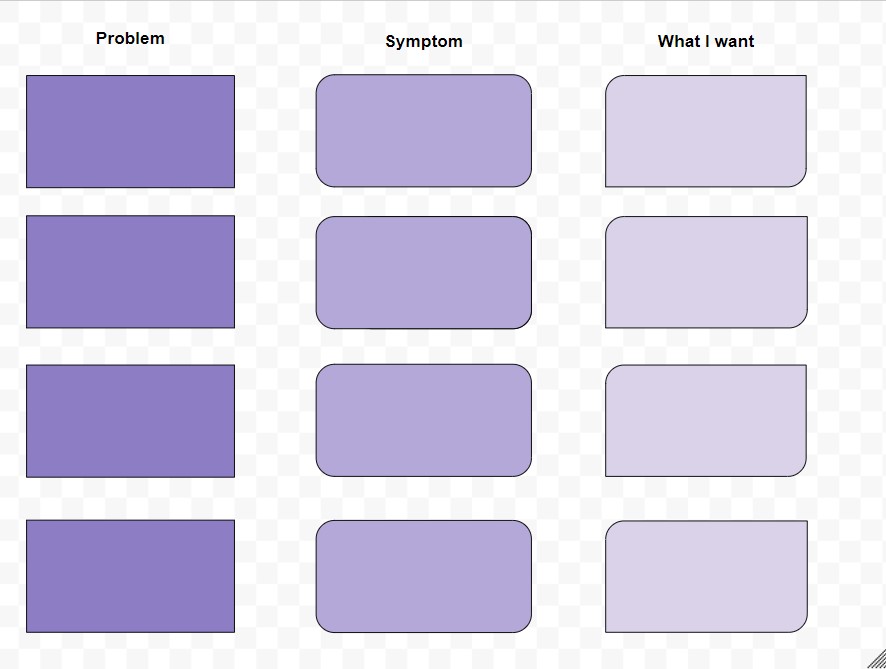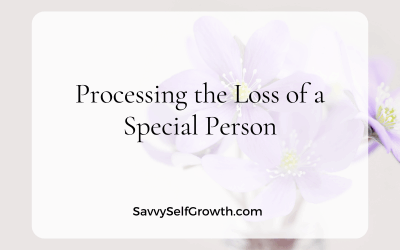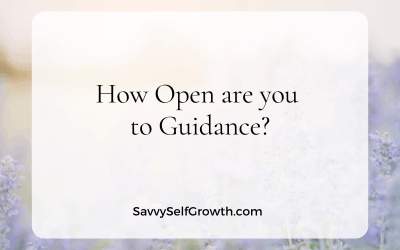I’ve heard this question so often: “I want to tap for my issues because I know EFT can help. But I don’t know where to start, or what to tap for. It’s a mess in my head.”
This question usually comes from someone who has felt the benefits of EFT in a group tapping or private session, I was an EFT trainer for a number of years and this came up often even after being trained.
I know exactly what this feels like, having been there myself. It’s hard to see the woods for the trees when we’re deep inside our own issues, especially if it’s an issue that’s been around for a long time.
One useful approach to know what to tap for
I’d like to share one helpful way to approach using EFT for self-help if you don’t know where to start or what to tap for.
First, the fine print
There are a few instances where I would not recommend this approach.
Number One is If you’ve had a Big T trauma where your life really was in danger. For that, please go to a trained practitioner instead. Big T’s are things like abuse, serious accidents, crime, war, natural or other disasters (tsunami, earthquake), and similar. It’s very, very hard to be the doctor and the patient at the same time for these types of events. We need to feel safe to heal trauma. A trained practitioner will use safe techniques to make sure that happens.
Also, for this approach, you need to have at least a working understanding of EFT, where the points are, and how to determine what to say. Basically, telling the truth about something while you tap is what we do.
The Foundation of this Approach
The basic problem when we try to figure out ‘what to tap for’ is that we don’t have distance from our problems.
Trying to figure out what to tap for while being immersed in it is like trying to navigate a maze while being trapped inside of it. When you’re in the middle of the maze, it’s hard to see the bigger picture and the way out. You can’t get a bird’s-eye view of the maze to find the most efficient path to the end. Similarly, when we are too close to our problems, it can be difficult to gain the necessary perspective and clarity to figure out how to tap to solve the issue.
The approach I’ll give you, will help you to gain a bit of perspective, and give you ideas for starting points.
On that note, there are 2 different ways to use EFT:
- Symptom relief in the moment. This is often what we do when we tap for self-help.
- Getting down to the roots and clearing the origins of the problem. It’s a tad harder to do this by ourselves for a few reasons, yet it’s still possible to make progress. I wrote a more in-depth article on that here.
The approach I’ll explain might get you quite a way down the road to clearing your problem or issue. Yet be mindful that sometimes much of the root cause is hidden from ourselves, like being in our own blind spot. If it feels like you’re not making progress, do reach out to a certified practitioner.
What’s the outcome of using this approach?
When I meet with a new client, we spend our first session getting what’s in their head, onto an online board. We meet remotely so I use a tool that we can both see. I use Google Drawings to draw a diagram, and then we type the issues on that board. As we go on our journey, we can then keep checking against what we completed in our first session.
Every client I’ve used this for has told me something like this after that session:
- I can see all the issues so much clearer now.
- It doesn’t feel inside me anymore now that I can look at them.
- It’s less scary and less of a mess now that I see them there.
- I know where we’re going.
- I know what we’re going to work on.
- I feel relief and clarity.
Here are the basic steps for my approach:
- Get it out of your head where you can see it.
- Pick one small piece.
- Tap till it doesn’t feel true or a bother anymore.
- Repeat steps 2 and 3.
- Check or test your original issue as you make progress.
Step 1: Get it out of your head.
Here’s the template I use as an example. You can make it simpler too, as described below the diagram.

In the ‘Problem’ box, type the overarching issues you have like:
- I feel misaligned with my office culture.
- I fear putting myself out there.
- I can’t be myself.
- I lack confidence.
For the ‘Symptoms’ box, type how you know you have this issue:
- I feel frustrated at the office and lose my temper.
- I don’t take any action on building my business or putting myself out there.
- Friends ghost me.
- I’m anxious when I’m with other people.
The ‘What I Want’ box contains what you’d love instead of what’s in the Problem box.
- I want clarity about whether this environment and office is right for me.
- I want to stop worrying what others think of me and start my business.
- I want to do what makes me happy.
- I want to feel a sense of worth when I’m with others.
Other ways to get it out of your head
You don’t have to use this exact template. Why not try a mindmap with branches like ‘Problem’, ‘Symptoms’, ‘Wants’? Or if lists work for you, simply write them in a list format.
Another, perhaps simpler way, is to use this format:
- Current situation (describe it briefly)
- What happens (my behaviour/someone else’s behaviour – the symptoms)
- How I feel about it (sad, angry, despondent)
- My thoughts / beliefs about it (This will never end, I’m doomed, this will only get worse, I’m not good enough, I’m unacceptable)
- What I want instead
- What I want to happen (behaviour)
- How I want to feel (relief, relaxed, calm, inspired)
- What thoughts / beliefs I’d rather have (I can heal this issue, it’s possible for me to be free of this, I’m good enough, I’m lovable)
Step 2: Pick a small piece.
Pick a small enough piece that feels manageable. It can be the look on someone’s face as they scolded you, the tone of voice, or the volume. Or it can be how it made you feel at the time. It can be how you feel today as you think about it. Or it can be what you made it mean. There are hundreds of ways you can pick one small piece. If it feels daunting to tackle, pick a smaller piece, or get support. Always, always get support if it feels too big to handle.
Step 3: Start Tapping.
Now, it’s time to start using EFT to do some tapping! There are so many ways to do this, and there is no right or wrong, better or worse way.
Whatever form of EFT you love most, just start tapping. You can use traditional tapping (“Even though I have this x, I love and accept myself”), or silent tapping, or Intention Tapping, or ‘talk and tap’. Here’s a list of easy ways to incorporate tapping into your days.
Tap with your one selected piece in mind till it’s free of any emotional charge.
Keys are
- pick a small enough piece so it feels manageable,
- be persistent,
- write down where you got to at the end of your tapping session (and a session can be 5 minutes!)
Perhaps have a journal where you record your tapping journey, so you can jot down an aspect (a small piece), how distressed you were when you started and ended.
For instance:
- The look on their face when they said those words.
- Beginning of session: 8/10 hurt in my heart
- End of session: 3/10 hurt, and more peace too
An important note about tapping positive statements:
Some people want to jump too quickly to ‘tap for the positive’ or how they want it to be. The trouble is – that’s not addressing the blocks and subconscious beliefs that are running the show. We first need to discharge what’s really going on, before we can use any ‘positive’ tapping.
We need to address what’s in the way of our vision. Do that in one of two ways:
- Use everything undesirable in the current situation and tap for that.
- Use the ideal situation and use ‘Yes but I can’t have that because’ to elicit what’s in the way, and discharge that with EFT.
Step 4: Repeat Steps 2 and 3
Ideally, we want to have as much freedom as possible from our issues. Pick another piece every time one of the pieces feels resolved.
As mentioned earlier, sometimes we need the support of a practitioner who is trained to help us find hidden aspects. Maybe we discover there’s a piece that is just not shifting. That’s an indication to get support. It’s not an indication that EFT does not work. It usually means, there are aspects that we have not been able to find on our own.
Remember being in the maze. A brain surgeon does not operate on himself, no matter how skilled he may be.
Step 5: Test
Gary Craig, the creator of EFT, was adamant about regular testing. How else will we know if we’ve made progress? Tap regularly and consistently for your issue, and every now and again check against your original list.
A word of caution:
Do not look for a complete resolution after one tapping session! Our long-standing patterns especially need a lot of care and attention, and often outside support (from a practitioner). Look for signs that you’re making progress. In this article, I describe a valuable method to look for progress, instead of the pressure that the whole thing must be gone within a few sessions.
Cut yourself some slack. In my experience our issues did not appear overnight, so we have permission to take a while to solve them.
In a nutshell:
We don’t need to resolve an issue overnight. Instead, we can evolve it over time with knowing what to tap for.
We can make consistent progress on issues by getting them out of our heads, picking one small piece, and tapping for that piece. And then the next, and so on. Our issues are usually made of many different aspects (pieces) that form a big whole called ‘The issue I have’.
What questions do you have about this approach? Have you tried breaking it down like this? What else do you need to make progress with tapping? I’d love to hear from you in the comments, or drop me a note.




